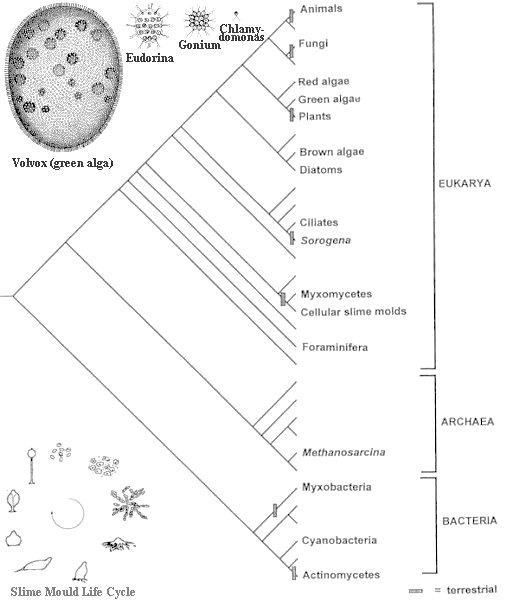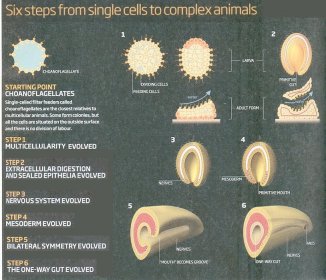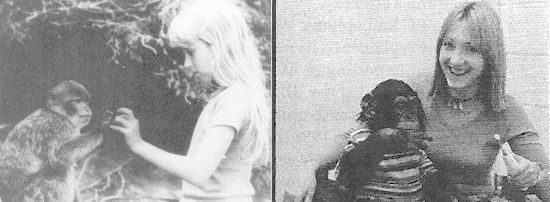
| Home Page | Overview | Site Map | Index | Appendix | Illustration | About | Contact | Update | FAQ |
 |
Figure 10-03 reconstructs the evolution of the multi-cellular organisms. It shows the primitive form of life existed in much of the Earth's history and are all water-based. Complex life forms started only in the last 580 million years. Water-based life is illustrated in the bottom half of the picture, land-based life appeared later as shown in the top half. Multicellular organisms have arisen independently a number of times starting from about 1.5 billion |
Figure 10-03 Evolution of Life [view large image] |
years ago when the atmosphere contained sufficient oxygen to support the higher energy requirement for multicellular life. |
 |
Thirteen separate inventions of multicellurity are indicated in Figure 10-04a. The attempt to become multicellular seems to happen by chance, e.g., the pair of cells failed to separate during cell division, or two cells stuck together accidentally. If natural selection favoured this new form, it would survive and prosper. The advantage can be varied. It could be for better dispersal of spore (by a long stalk), for staying in one place (with a root), more efficient feeding, or for confronting predator. One theory suggests that since there is always an open ecological niche for large size organisms, evolution favours bigger size to escape competition with the smaller ones. However, increase in surface area of the cell is always lagging behind increase in volume1, the expanding organism has to go multicellular and to develop specialized cell types (i.e., to move toward greater complexity) to resolve this problem. Figure 10-04c shows the relationship between size and speed of different objects. For living animals, speed is essential for pursuing preys or escaping predators. The broad band in the graph represents the condition on the surface of the Earth where living beings exist in a habitable zone. Note that the largest molecules and the smallest bacteria converge at the point of slowest motion of all of life and of all non-living bodies. It is the realm of Brownian motion where the floating of pollens and some bacteria is supported by the random motion of molecules in the medium. |
Figure 10-04a Multicellularity |
Beyond this size, the animals propel themselves with their internal energy. As the size increases, there will be a myriad of consequences on: |
 |
 |
Another problem with multicellular is related to the requirement of a single-cell stage in the life cycle. Sexual reproduction2, for meiosis and fertilization can only be achieved in a unicellular stage in eukaryotic organisms. The reason has to do with the way the genetic material is incorporated into chromosomes, and with the separation and recombination (crossover) of the alleles (two versions of the same gene) at meiosis. The fusion of the genes from two parents can only take place in single cell. A scenario for multicellular evolution in six steps starting from choanoflagellates has been proposed in 2009 as shown in Figure 10-04d. |
Figure 10-04c Size and Speed of Objects [view large image] |
Figure 10-04d Multicellular Evolution [view large image] |

 ________________________________________
________________________________________
 ________________________________________
________________________________________ , see "Slime Moulds Life Cycle" ________________________________________
, see "Slime Moulds Life Cycle" ________________________________________ , see "Biological Classifications"________________________________________
, see "Biological Classifications"________________________________________ , see "Genomes"________________________________________
, see "Genomes"________________________________________ ,
, 
 , see "Functions of the p53 Protein".________________________________________
, see "Functions of the p53 Protein".________________________________________
 , see "What Makes Us Human?";
, see "What Makes Us Human?";  , see "Human Race in Future"
, see "Human Race in Future" ________________________________________
________________________________________1Since the volume increases (as ~ length3) faster than the surface area (as ~ length2), a single cell cannot enlarge its size indefinitely. It has a limit beyond which the surface area is not capable of absorbing enough nutrition (including oxygen) and draining off excessive waste.
2Sexual reproducation endows genetic variations and replaces damaged genes. Cloning negates these evolutionary advantages by skipping the haploid phase of the life cycle (see Figure 10-05). Dolly, the world's first cloned sheep has died on February, 2003 at the age of 6 after a veterinary examination confirmed the lung disease. Sheep can live to 11 or 12 years of age and lung infections are common in older sheep, particularly those housed inside. She has developed other old age symptoms such as arthritis, a condition usually expected in older animals. Research in 1999 suggested that Dolly might be susceptible to premature ageing -- a possibility raised after a study of her genetics.